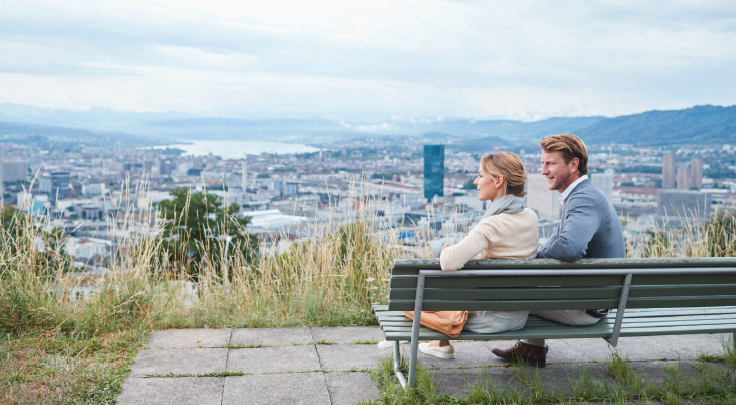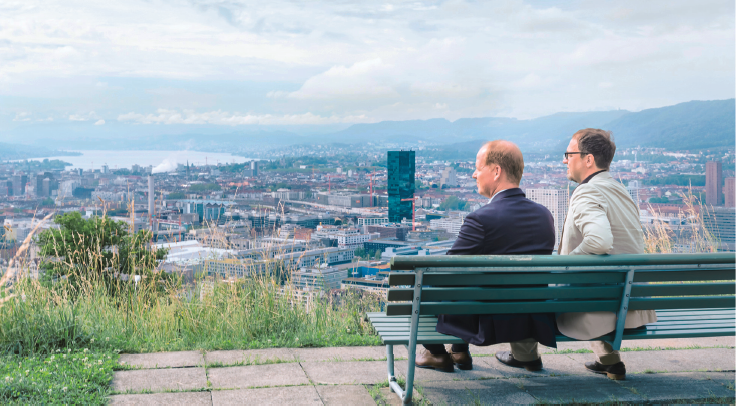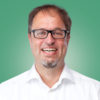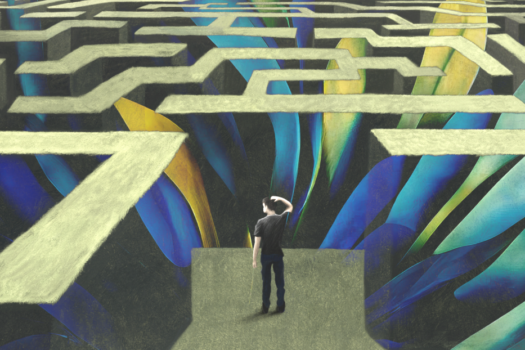In a classic atmospheric picture chosen for the annual report of the Swiss Prime Site Group, a couple sits on a bench looking out over the city from the “Zürcher Waid,” the Prime Tower that dominates the urban west of Zurich. Many figures, graphics and interviews follow in the next 200 pages, alongside talk of business successes, governance, innovation and, of course, sustainability—the magic word of the hour. Urs Baumann, Head of Sustainability and Innovation at Swiss Prime Site and the leader of real estate project development, was one of many involved in realising this publication. He was supported by Stephan Lienin, partner at the consultancy firm Sustainserv, and Keila Gromann from the Therefore agency. We asked these three people to join together on the “Zürcher Waid” and take a seat on the same park bench as the models in the report. A lively conversation about innovation, sustainability and communication ensued, moderated by Thomas Gromann.


If you flip through the annual and sustainability reports of Swiss Prime Site, you will read they are “successful, sustainable, innovative.” Really, Urs Baumann? Are these three adjectives a corporate counterpart to “young, dynamic and successful”? Isn’t that what everyone claims to be today?
Urs Baumann (UB): (Laughing) I find it difficult to judge what others assert about themselves. It is important to me that we ourselves are comfortable with the statements we make. We are financially successful, as our key financial figures prove; we document our sustainability to the smallest detail on over 100 pages in our sustainability report; and innovation is part of our DNA and thus also embedded in our sustainability strategy.
The fact that you are not only Head of Innovation and Sustainability at Swiss Prime Site, but also Head of Development…
UB: …in no way means that the tasks are only performed in a secondary capacity. On the contrary, our development projects offer the best prerequisites for the implementation of our sustainability strategy and showcase our willingness to constantly innovate. The combination of these disciplines is a tremendous opportunity and strong preparation for the future.
Stephan Lienin, you support Swiss Prime Site on the topics of sustainability and innovation. What is your role in this?
Stephan Lienin (SL): We support Urs Baumann and his team in further developing a sustainable business model in several respects: how to create value through innovation, integrate this into sustainability management and report on it.
Is it possible to describe in brief and concrete terms what “creating value” means specifically for Swiss Prime Site?
UB: When we approach project development, we design an investment to last for several decades and factor in operational issues as well. I am now less concerned with building services such as engineering and the like, but rather with fundamental issues. We try to anticipate how the city, the legal framework, society, etc. will change. We ask ourselves what demands our properties will have to meet in the future and how we can create and maintain value in the medium and long term through sustainable planning.
SL: Sustainability and innovation complement one another because they are equally affected by long-term megatrends. And it is certainly possible to make certain statements about the future based on scenarios. A good example of this is climate change.
Thus, installing air conditioning systems to take account of climate change?
UB: That thinking is too short-sighted. First, climate change puts enormous pressure on politicians and the framework conditions are changing rapidly. Interestingly, we are experiencing this dynamic especially in metropolitan areas and not necessarily on a national level. At present, cities such as New York, Copenhagen or Vienna are the drivers when it comes to sustainable planning. Investors and developers must be prepared when cities introduce climate budgets and change the rules of the game with relatively short notice.
SL: In a joint workshop with Swiss Prime Site, we explored a climate scenario for Zurich in 2041: Not only will it be warmer, but numerous social trends caused by climate change will have significantly altered the environment. Stakeholders from the various business areas reflected on which infrastructure and services will be successful in such a scenario. This demands a completely new way of thinking about systems.
“It is about showing what value a company creates for itself and society.“
What does that mean?
SL: For example, if we anticipate further global warming, in 2041, we may experience summers in Zurich that are comparable to the weather conditions in cities like Singapore today. With our normative thinking, we would spend great effort to cool the rooms down to a tried and tested 22 degrees. On the contrary, leading planners in Singapore choose approaches that allow for comfortable living and working with warmer but moving air.
Sounds like a convection oven to me…
UB: There is not one single solution—many individual measures are needed to achieve an overall improvement. In fact, many planners still build in the way that is predominantly taught at universities to this day: Keep as much heat inside as possible, let as much light in as possible, and follow the numerous building labels, some of which are definitely outdated.
But since 2003, we have had completely different summers here. Much longer, much hotter. Thus, we need to take a new approach to temperature management if we want to avoid retrofitting energy-consuming air conditioning systems everywhere. Another issue that is still largely ignored in our latitudes is water management. We have too little water in summer and too much during heavy rainfall—and nobody knows what this will be like 15 years from now.
So innovation and sustainability mean focusing on climate change?
UB: No, this is just one aspect of a long list of trends we must deal with. Our next innovation workshop will address the topic of value shift. In general, however, the UN has defined the 17 goals for sustainable development, and we too are guided by them. Out of the 17 Sustainable Development Goals (SDG), we focus on goal 11, which relates to sustainable cities and communities. In doing so, we address the key issues that arise in relation to our business model and are able to align our activities and the corresponding impact in favour of sustainable development.
What about technical innovation?
UB: There is a great deal that we can already achieve with the current state of the art. On our behalf, a department of our subsidiary Wincasa records and monitors our entire property portfolio using various parameters. This allows us to react “property-specific” and replace heating systems, renovate facades, install photovoltaic systems or satisfy our electricity demand sustainably from hydropower. To return to the starting point of our discussion: This is an area where we are sustainable and successful because most of these measures pay off within a very short time, reducing our costs, increasing our profits, and protecting the environment.
SL: To tackle this issue in such a consistent manner is an important contribution to slowing down the rise in CO2 emissions and one that not all companies or property owners have taken yet. However, if we assume that global energy demand will double by 2050 and that we need to reduce CO2 emissions to net zero over the same period, we will soon have to start rethinking existing systems—for example, networking systems in the city to link buildings, energy and mobility while enhancing users’ quality of life. This is where gamechangers are needed.
Gamechanger, disruption. We are touching upon more buzzwords, and thus intersecting with communication. The annual reporting for Swiss Prime Site in 2017 and 2018 was realized by Keila Gromann as overall project manager at Therefore.
Keila, you have been listening in silence and nodding frequently. How do you credibly bring so much information about a vague future to the reader?
Keila Gromann (KG): I nodded because we at Therefore have been dealing with these questions for a long time. And to answer you: with concrete numbers.
Innovation and sustainability in figures.
KG: Yes, Swiss Prime Site reports financials not only in accordance with Swiss GAAP FER, but also the Sustainability Report 2017 contains many elements of integrated reporting. Currently, Swiss Prime Site quantifies and reports the six capitals of the value creation model to the extent possible and aligns their strategic roadmap accordingly.
And what exactly did the communication agency have to do with it?
KG: A lot! In the report several tables show in detail what is done with which results. But then our real work is to make the strategic results quickly comprehensible and strengthen credibility. The collaboration with Swiss Prime Site and Sustainserv was therefore very close.
SL: More and more investors today want to know how a company creates long-term value—financial success, but also added value for customers, employees and the environment. Reporting in particular must increasingly show how a company wants to shape the future.
KG: This is why we communicated on the company website, e-mail newsletters, social media and, finally, in the annual report about the many small steps on the way to achieving our goal. With selected interview partners from the company and also others, such as the founding partners of a start-up cooperating with Swiss Prime Site, we were able to show how the implementation of specific individual projects contributes to their overall success.
Are start-ups supposed to generate innovation and disruption?
UB: Through systematic innovation management, we have identified several areas in which we are looking for innovations—not only among established providers, but also among start-ups, of course. Time and again, we can involve such partners in very specific projects and be the first customer to develop the idea further or even invest in the idea. This is not an end in itself, but another measure to remain at the forefront of technology and business.
What will annual reporting look like in the future? How will a company be able to credibly show that it is successful in the long term?
SL: The future is integrated. The company shows what its business model looks like, the resources it needs, the value it creates and what impact it has. Further, it shares how it sees the future, what challenges it expects and how it intends to overcome them.
UB: This means that we not only talk about sustainability, but also set specific objectives, document the implementation, measure the results and communicate our roadmap in a binding manner.
KG: From a communications perspective, it makes sense to communicate not only once or twice a year, but continuously. The semi-annual and annual reports are then only consolidations. The future lies in making the information recordable and interconnected. This is another reason why the future of reporting is online, digital and omnichannel.
Thank you very much for the interesting conversation. Finally, which question did we forget to ask from your point of view?
UB: The one about “secondary benefits.” Through our innovation and sustainability projects we are an attractive employer for qualified and committed employees. To the top performers of today and tomorrow, it is increasingly important whether your current or future employer consciously accepts its responsibility. The younger generations have correspondingly high demands of their environment. We should therefore make an effort to keep a continuous, serious and credible dialogue and be one step ahead of our competitors in the “war for talent.” Here I am not only referring to our company, but also to our cities, which in this respect are in competition with the major cities in Europe and the world.
KG: Another interesting question is which one of the channels and media will reach the target groups in the future. Classical print publications and websites are okay at the moment, but will having all the information in one place and in this form still work in five years?
SL: I am currently interested in the challenge of integrated management:. External communication and internal action increasingly need better coordination in terms of strategy and operations. I think we’ll be having another interview in the future.
Portrait interviewees
Keila Gromann manages the consulting services at Therefore. As the specialist for integrated campaigns, she has already assisted a wide range of companies in the preparation of their annual report.
Urs Baumann is Head of Sustainability and Innovation at Swiss Prime Site and the leader of real estate project development.
Stephan Lienin is one of the founding patners of Sustainserv and works in offices in Zurich and Boston. Following his PhD in natural sciences at ETH Zurich, Stephan Lienin analysed energy and mobility systems at the renowned Paul Scherrer Institute.
Behind the story
The pictures in this interview were previously published in the Swiss Prime Site 2018 Annual Report, which was realised by Therefore in collaboration with the interview partners Urs Baumann and Stephan Lienin. For our portfolio, we have tried to recreate the subjects with them, and spin the report’s stories even further.
The beginning of the stories covered in this interview can be found in the annual report, which offers analysts, proxy advisors and shareholders an even more comprehensive picture of the business.
The original text of this interview was previously published in therefore.
Get in touch. We are happy to tell you more about it.





